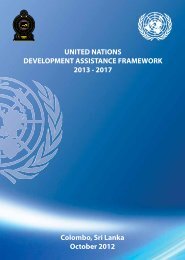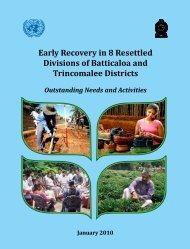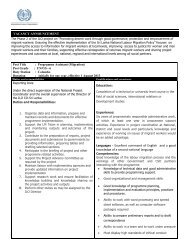Sri Lanka Human Development Report 2012.pdf
Sri Lanka Human Development Report 2012.pdf
Sri Lanka Human Development Report 2012.pdf
You also want an ePaper? Increase the reach of your titles
YUMPU automatically turns print PDFs into web optimized ePapers that Google loves.
Cultivation of paddy is another major economic activity<br />
in the Northern and Eastern provinces. One survey found<br />
that 54 percent of farmers cultivating crops were growing<br />
paddy, both rain fed and irrigated. 281 On the whole, crop<br />
diversification is low, with the highest level in Trincomalee.<br />
Farmers there grow vegetables, cereals, chillies and fruits,<br />
in addition to paddy. There is a moderate degree of crop<br />
diversification in Vavuniya District, while diversification<br />
is relatively low in Ampara and Batticaloa districts. 282<br />
Livelihoods outside agriculture and fisheries are limited,<br />
dominated overwhelmingly by microenterprises. The<br />
Government is another source of employment, while<br />
the industrial sector is diminutive, both as a source of<br />
employment and as a contributor to GDP, except in<br />
Trincomalee. In some districts, including Batticaloa,<br />
traditional cottage industries, such as pottery and weaving,<br />
are significant sources of income for women. Economic<br />
activities and households also depend heavily for income<br />
upon remittances from members working abroad. 283<br />
Several factors have hindered the growth of livelihood<br />
opportunities, including the lack of skills, technology,<br />
equipment, infrastructure (particularly irrigation),<br />
marketing know-how and market linkages. There are<br />
significant gaps in natural resource management. Many<br />
households do not have deeds for their land. In the Ampara<br />
District, a survey of the villages of Kanchikudichcharu,<br />
Thangabelautham and the 18th Colony of Damana found<br />
that about half the families did not have legally valid<br />
documents. 284 Though labour availability is not a major<br />
problem, skilled labour is in short supply, particularly in<br />
the Ampara District. 285<br />
Safe access to land is restricted in some places by mines<br />
planted during the conflict. By early 2011, 536 square<br />
kilometers of contaminated land has been identified in areas<br />
surveyed. 286 Surveys remain to be conducted in 6 Grama<br />
Niladari Divisions. In July 2010, the Cabinet approved<br />
the establishment of the National Mine Action Centre to<br />
coordinate and manage all mine-related activities. Given<br />
limited existing capacities for demining operations, the<br />
Government has allocated the highest priority to land<br />
needed for resettlements and livelihood activities near<br />
resettlement areas. According to the latest available data,<br />
between 1st January, 2009 and 31st December 2011, 555<br />
square kilometers of land were released for resettlement<br />
through mine/Explosive Remnants of War (ERW)<br />
clearance, in addition to the release of large stretches of<br />
land certified as safe through non-technical surveys. 287<br />
Another serious issue affecting agriculture is inadequate<br />
access to inputs and services. Obtaining seed paddy, for<br />
example, is a major problem in Batticaloa and Vavuniya<br />
districts. These constraints, coupled with water scarcity<br />
during the dry season, have been mainly responsible for<br />
low productivity. Water is not a huge problem for paddy<br />
cultivation in Batticaloa and Trincomalee, where it is<br />
done mostly under rain-fed conditions, and Ampara,<br />
where irrigated cultivation is prevalent. Agro-wells have<br />
emerged as important sources of water, with high usage in<br />
Trincomalee and Vavuniya districts. 288<br />
Extension services are poor except in Trincomalee, and the<br />
use of technology in agriculture is very low. One survey of<br />
farmers in Trincomalee District found that they are not<br />
aware of new technologies and remain heavily dependent<br />
on traditional farming methods. 289 Programmes need to<br />
be in place to raise awareness about available technology<br />
and other inputs for increased production.<br />
Most households lack access to credit, for reasons such as<br />
the lack of facilities, lack of trust, restricted lending only to<br />
the members of microfinance institutions, limited collateral<br />
and the inability to provide guarantors for loans. 290<br />
Banks have been reluctant to supply credit for rain-fed<br />
cultivation due to the risks associated with it. Credit for<br />
livestock-related livelihoods has been relatively scarce. 291<br />
Many of the problems with livelihoods in agriculture<br />
and fisheries have an additional impact by limiting<br />
movement to other livelihood options. The unavailability<br />
of infrastructure to add value to agricultural production<br />
(through, for example, rice processing), the lack of market<br />
linkages and integration, the underutilization of skills, and<br />
obstacles to accessing credit, all constrain movement out<br />
of agriculture into alternative livelihoods.<br />
Large-scale investments by the Government and donors<br />
have not brought immediate benefits to local economies, as<br />
had been anticipated. This has been due in part to practices<br />
such as the use of contractors and labourers from outside<br />
localities, thus restricting opportunities for local people<br />
to gain new incomes and skills. Other options could be<br />
explored. Tourism, for example, has great potential, with<br />
the right infrastructure in place. 292<br />
Chapter 5 Bridging <strong>Human</strong> <strong>Development</strong> Gaps: Employment and Livelihoods 99






